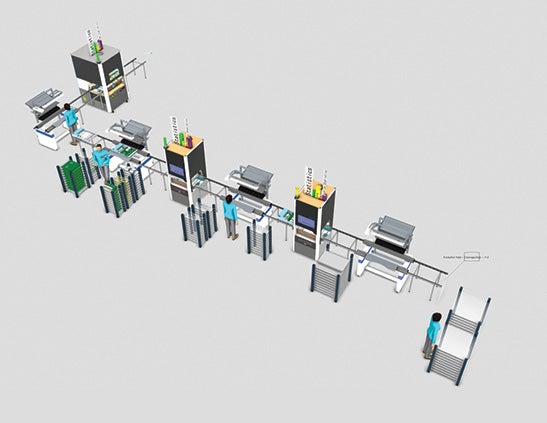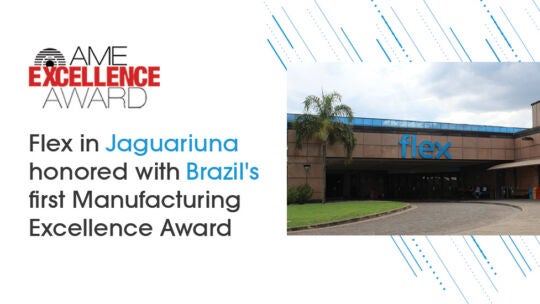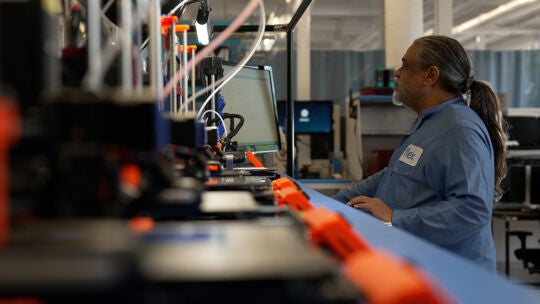
In an increasingly interconnected world, the need for automated manufacturing on a global scale is critical. Automated systems, driven by advanced technologies such as robotics, artificial intelligence, and the Industrial Internet of Things (IIoT), offer a multitude of advantages that address critical challenges faced by industries and economies.
Enhanced precision, speed, and consistency in production processes lead to higher product quality and reduced defects. Moreover, automated systems can operate around the clock, accelerating production cycles and meeting demand fluctuations more efficiently. Embracing automated manufacturing on a global scale is not just a pathway to economic growth, but a means to establish sustainable, agile, and technologically advanced industries that can navigate an uncertain future.

Flex is committed to providing the most advanced global automated manufacturing systems at our 30+ global manufacturing sites to optimize customer outcomes. We’ve made significant investments in new technologies that will automate manufacturing processes for transformative operations.
We recognize a need to simplify the process of simulating automated manufacturing so that our employees and customers can more easily collaborate on design reviews of the mechanical parts and components that go into products.

To meet this need, we have developed two tools: Digital Design for Automation (DDFAUT) and Digital Design for Automation Line (DDFAUT Line). These tools allow teams across Flex to save on time and resources while scaling to create innovative products for our customers. With hundreds of design reviews now complete, we’ve reduced the time it takes for design concept validation significantly.
The road to digitized automation engineering
Typically, when developing an automated manufacturing system, automation engineers will perform a benchmarking analysis. They will also generate internal concepts and all the required business/technical justifications. Then, to design and analyze the automated manufacturing solution, they will use multiple tools, such as CAD modeling, ROI, Internal Quotation, IE analysis, and BOM generation. These steps require different tools and the need to perform a “what if” analysis that evaluates all options to generate the optimal solution.
This process can be tedious, time consuming, and inaccurate. To provide a more streamlined approach, Flex developed an integrated digital solution that automatically guides the engineer to the optimal decision, while providing a collaborative knowledgebase globally that further fuels increased efficiency.
Flex innovative tools for enterprise-wide automated manufacturing
With DDFAUT and DDFAUT Line, Flex provides our customers with a standardized centralized tool that provides all the required outputs needed to optimize automated manufacturing solutions. The tools automatically track assumptions, perform “what if” analyses to understand downstream effects, and guide users (who may not be an expert in automation or simulation) to find the optimal solution.
DDFAUT helps analyze a product design based on a rules database that checks elements such as BOM, interference and symmetry, while also operating as a plug-in for SOLIDWORKS 3D CAD design software. At the same time, DDFAUT Line conceptualizes and validates the automated manufacturing assembly line. Automation engineers can use active components and templates to automatically generate reports to validate the system for cycle time, robot reachability, space, collisions, and ROM quote, for example.
These enterprise-level solutions enable engineers and line-of-business employees to generate and validate automated manufacturing solutions, including all required customizations, in a standardized and digitized manner.
Flex development approach to automated toolsets
The goal of the project was to create an enhanced simulation tool with a custom logic, UI, and workflow that enables the end user to generate the required outputs for optimized automated manufacturing solutions, while reducing concept generation and validation times. DDFAUT and DDFAUT Line can be used for custom automation solutions and to benchmark and validate external quotes and concepts for turnkey solutions.
Flex has created a database containing more than 16,000 rule items that can be customized for specific product types or business segments, along with a database of automation components that can be used for faster modeling and validation of automated manufacturing systems.
While the project started out small with a proof of concept at a handful of Flex’s manufacturing sites across the world, the benefits were immediate and obvious, and we subsequently deployed the capabilities globally. The automated manufacturing system is now live in every Flex facility globally.
Our shared knowledgebase continues to rapidly expand and fuel increased efficiency. Project expertise and knowledge attained in one facility can be easily shared to any Flex facility around the world, making it easier for different geographies to effectively collaborate.
The project also helps Flex ensure ongoing resiliency by removing geographic barriers for knowledge sharing and production. With DDFAUT and DDFAUT Line, Flex can deliver product-specific capabilities to any Flex facility.
Reduction in the time it takes for a successful product ramp

By providing a global, enterprise-wide system that provides true automated manufacturing analysis, Flex delivers myriad benefits to customers, including:
- Reducing the time it takes for concept validation: In some cases, concept validation time has been reduced by up to 50%.
- Enhancing the accuracy of creating automation lines: Flex’s tools are accurate to the sub-millimeter level, allowing for more precision and accuracy. In the initial stages, accuracy is especially critical, as mistakes can have far-reaching downfield impact when exacerbated by production at scale.
- Reducing the time it takes to conceptualize and roll out the necessary components of a successful product ramp: A manual process that once took several weeks can now be accomplished in 24–48 hours when digitized.
The project serves as the underpinning for continued digital transformation across Flex’s global locations. DDFAUT and DDFAUT Line are part of Flex’s Industry 4.0 (I4.0) strategy and investments that advance our operations and empower customers to be more agile, efficient, and competitive.


